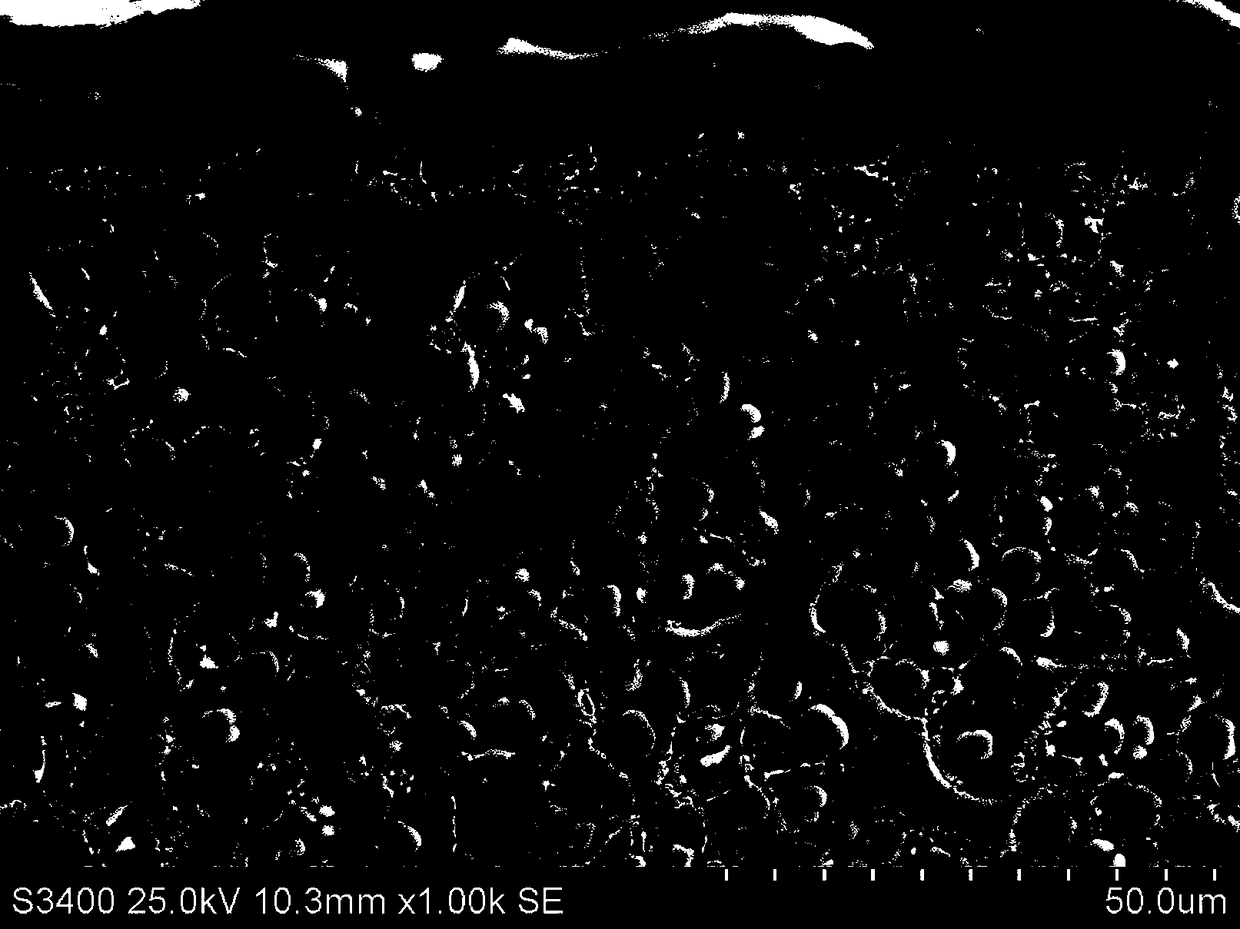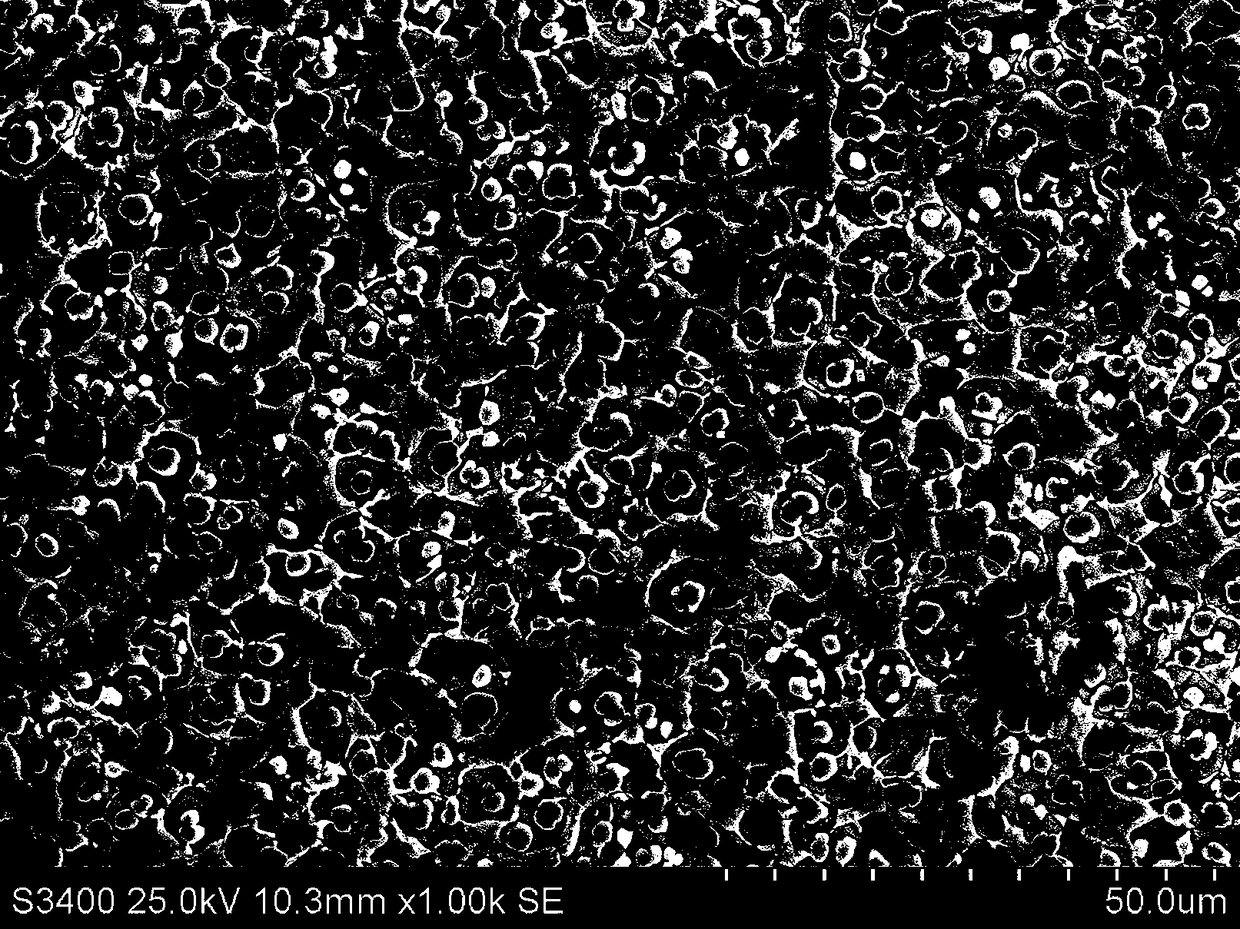Powder for laser cladding in-situ self-generated vanadium carbide reinforced iron-based alloy and preparation method
An in-situ self-generated and laser cladding technology, which is applied in the coating process and coating of metal materials, can solve the problem that it is difficult to control the sufficient and uniform mixing of the reinforcement phase particles and the coating powder, and the poor combination of the reinforcement phase particles and the matrix interface , It is impossible to guarantee that the reinforcement phase particles will not be polluted, etc., to achieve the effect of strong bonding strength, low price, and enhanced wettability
- Summary
- Abstract
- Description
- Claims
- Application Information
AI Technical Summary
Problems solved by technology
Method used
Image
Examples
Embodiment 1
[0045] Using alloy powder I to prepare V on the surface of low carbon alloy steel substrate 8 C 7 Particle-reinforced iron-based alloy laser cladding layer.
[0046] The composition (mass fraction) is C 4.00%, V 16.00%, Cr 8.00%, Si 0.90%, Mo 1.00%, Mn0.90%, Ni 0.40%, Al 0.30%, the total mass fraction of P and S≤0.03% , O≤300ppm, and the rest is Fe. The alloy powder I was dried in a vacuum oven at 120°C for 2 to 5 hours, and then the laser cladding test was carried out. Using CO 2 The laser is used for laser cladding, the laser beam wavelength is 10.64μm, the laser power is 4.0kW, the scanning speed is 400mm / min~700mm / min, and the overlapping rate of multi-pass laser cladding is 50% for large area processing. The speed of the powder feeder in the synchronous powder feeding method is 600r / min, the purity of the shielding gas Ar is 99.95%, and the speed of the shielding gas is 10-20L / min. The thickness of the obtained laser cladding layer is 0.6-0.9 mm.
Embodiment 2
[0048] Prepare V on the surface of low carbon alloy steel substrate by using alloy powder II 8 C 7 Particle-reinforced iron-based alloy laser cladding layer.
[0049] The composition (mass fraction) is C 4.20%, V 17.00%, Cr 9.00%, Si 1.10%, Mo 1.50%, Mn1.10%, Ni 0.50%, Al 0.40%, the total mass fraction of P and S≤0.03% , O ≤ 300ppm, and the rest is Fe alloy powder II to be clad in a vacuum oven, dried at 120 ° C for 2 to 5 hours, and then the laser cladding test. Using CO 2 The laser is used for laser cladding test, the laser wavelength is 10.64μm, the laser power is 4.0kW, the scanning speed is 400mm / min~700mm / min, and the overlapping rate of multi-pass cladding is 50%. The speed of the powder feeder in the synchronous powder feeding method is 600r / min, the purity of the shielding gas Ar is 99.95%, and the speed of the shielding gas is 10-20L / min. The thickness of the obtained laser cladding layer is 0.6-0.9 mm.
Embodiment 3
[0051] Prepare V on the surface of low carbon alloy steel substrate by using alloy powder III 8 C 7 Particle-reinforced phase iron-based alloy laser cladding layer.
[0052] The composition (mass fraction) is C 4.40%, V 18.00%, Cr 10.00%, Si 1.30%, Mo 2.00%, Mn 1.20%, Ni 0.70%, Al 0.50%, the total mass fraction of P and S≤0.03%% , O ≤ 300ppm, and the rest is Fe alloy powder III to be clad in a vacuum oven at 120 ℃ for 2 to 5 hours, and then conduct a laser cladding test. Using CO 2 The laser is used for laser cladding, the laser beam wavelength is 10.64 μm, the laser power is 4.0kW, the scanning speed is 400mm / min~700mm / min, and the overlapping rate of multiple passes of large-area cladding is 50%. The speed of the powder feeder in the synchronous powder feeding method is 600r / min, the purity of the shielding gas Ar is 99.95%, and the speed of the shielding gas is 10-20L / min. The thickness of the obtained laser cladding layer is 0.6-0.9 mm.
PUM
| Property | Measurement | Unit |
|---|---|---|
| Thickness | aaaaa | aaaaa |
| Hardness value | aaaaa | aaaaa |
| Hardness | aaaaa | aaaaa |
Abstract
Description
Claims
Application Information
 Login to View More
Login to View More - R&D
- Intellectual Property
- Life Sciences
- Materials
- Tech Scout
- Unparalleled Data Quality
- Higher Quality Content
- 60% Fewer Hallucinations
Browse by: Latest US Patents, China's latest patents, Technical Efficacy Thesaurus, Application Domain, Technology Topic, Popular Technical Reports.
© 2025 PatSnap. All rights reserved.Legal|Privacy policy|Modern Slavery Act Transparency Statement|Sitemap|About US| Contact US: help@patsnap.com



